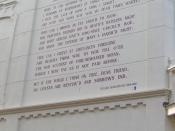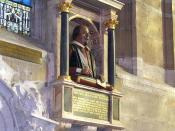William Shakespeare (1564-1616) was a favourite with both Queen Elizabeth I (1558-1603) and King James 1 (1603-1625), and is arguably the most influential writer in history. Author of hundreds of literary works, he remains a pioneer of English literature. Shakespeare's contributions to the literary world include over 30 plays and a collection of 154 sonnets which have become world-renowned as some of the best poetry ever written. The sonnets have for centuries intrigued scholars and experts. Indeed, his sonnets have become so well known that the style of sonnet he wrote, formally called the Elizabethan sonnet, has come to be commonly called the Shakespearean sonnet. An Elizabethan sonnet contains for sections: three quatrains and a couplet. The quatrains have a rhyme scheme of ABAB, and the couple rhymes CC. Each quatrain develops a certain metaphor which illustrates the theme of the poem, and the couplet offers either a summary of the poem or a solution to the problem presented in the poem.
Shakespeare creates in his sonnets a rich sequence that subverts the traditional roles of love poetry. All the poems that praise love and beauty are written seemingly for a man, and those in which the speaker is bitter and harsh, a woman is the target.
Just whom the sonnets were actually written for is a much-disputed matter, but it is generally believed that first 126 sonnets seem to be directed towards a young nobleman with whom the speaker is completely enamoured. The rest of the sonnets, save the last two, seem to be for a mysterious woman whom the speaker both loves and hates. Regardless of who they were for, the sonnets revolve around a few central themes, mainly beauty, love, and death, the three of which are all subject to the one obsession of Shakespeare's sonnets:...



Shakespearian Sonnets
This is a really great essay on Shakespeare and his sonnets. It gives an accurate and presice idea about him and his poems.Good work
2 out of 2 people found this comment useful.